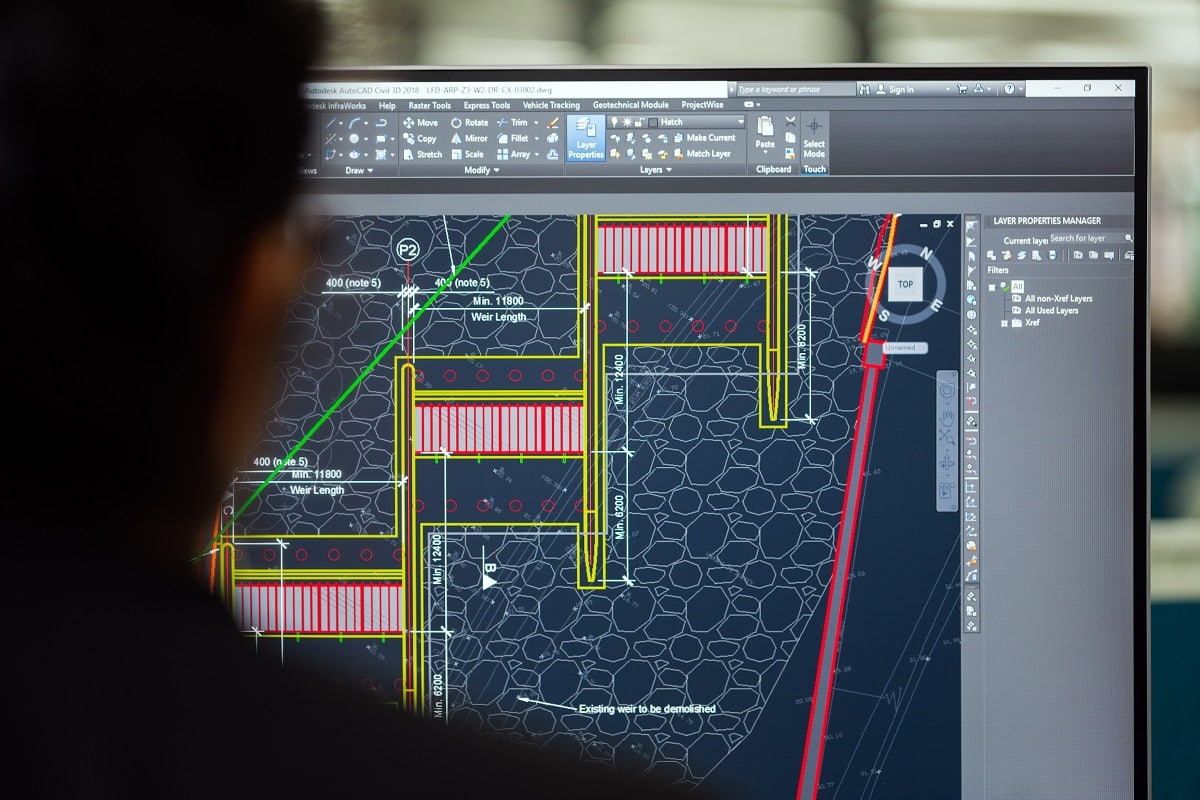Are you fascinated by the structure and intricacies of high-rise buildings with a zeal for creating something different?
Well, if you’re looking to leave your mark in modern society, then you might be better off becoming an architect. Like most professions, architecture requires passion, and with society changing at a rapid pace, it’s necessary to make buildings that meet modern standards.
We’re not only referring to the layout, but the times demand that you’ve to prove yourself at various steps along the ladder to qualify as an architect. It’s an intricate profession that needs several qualifications, but there’s no reason to be overwhelmed.
To help you, we’ve narrowed down all the steps that one must follow to make it as an architect. Along with enthusiasm, you need to know everything you’re expected to do, academically and experience-wise, allowing you to plan accordingly.
So, without further ado, let’s dive into the world of building plans and blueprints.
Basics Of Architecture

What Does Architecture Entail?
As an architect, you’ll be involved in making numerous structures from hospitals to government buildings and, of course, civilian households. Designing a building consists of a series of detailed steps, and you’ve to consider numerous factors like safety, legal concerns, and the practicality of construction at any particular spot.
Furthermore, you’ve to be involved in every step and act as the connecting link from the time the plan is conceived until it’s brought to fruition. No surprises then, that you should be ready to burn the midnight oil because meeting deadlines along with the quality of work is essential to uphold your reputation as an architect. For people to trust you, you can’t afford to be complacent.
But that’s true of any profession, so there’s no need to be worried. There are, however, specific skills that one needs to cement their place in the world of architecture. Firstly, you must have strong communication skills, backed up by a penchant for critical thinking. It’s essential to mention that you need to be organized to handle all the steps effectively.
Moreover, it’s vital to be visually aware of replicating the blueprint in actuality. To do that, you’ve to have a working knowledge of the latest technology being used and the tools for your purpose. It’s best to be well prepared rather than expect others to teach you how to operate modern machinery.
How Much Do Architects Earn?
We’re sure one of the first questions that comes to mind is related to the pay architects receive. On average, you may get close to $89,560, but the figure is likely to vary because it’s determined based on people who regularly handle projects.
When you start, you’ll have to work for long hours without any substantial pay and, therefore, you need to be prepared to grind it out. Like most jobs, no one’s going to pay you the big bucks right at the outset. You’ll have to work your way through several lesser paid projects before landing the first big paycheck.

Academic Qualifications Required
Now, coming to the academic requirements, you’ll have to get a bachelor’s degree in architecture from any institute accredited to the National Architectural Accrediting Board (NAAB). The course lasts for five years, at the end of which you’ll earn a degree termed as Bachelor of Architecture.
Moreover, more than 100 colleges offer the course, so you don’t need to worry. As part of the program, you’ll learn about producing systems and technology, managing projects, planning for the environment, and supervising the various structural elements.
Meanwhile, you can also enroll in various competitions that are specifically targeted towards students in architecture. One of these competitions is hosted by the Association of Collegiate Schools of Architecture, which presents a good platform for kick-starting your career. Most of these competitions have a theme and require participants to think out of the box.
It promotes innovative thinking and offers an insight into what you can expect in the field. Besides, you get to meet top professionals who know what it takes to succeed, and they offer the necessary inputs to help you improve. And at the end of the competition, you can add experience to your resume and showcase your work during interviews.
Another factor to keep in mind is that the bachelor’s degree requires a candidate to have at least 150 credit hours in professional and elective studies. Similarly, if you choose to pursue a Master’s degree in the field, then the credit hours increase to 168, out of which 30 must be at the graduate level.
For further studies, you can opt for a doctorate or Doctor of Architecture, which requires 120 credit hours at the undergraduate level and 90 hours at the graduate level. But there’s no need to feel burdened as the course at various universities will ensure you meet all the requirements.

How To Gather Experience?
Before you can become a licensed architect, it’s necessary to gather the relevant experience, which is made possible by the Intern Development Program (IDP). It’s catered to help amateur architects acquire the required work experience by involving them in multiple projects. It aims to promote learning and development, but the program is also mandatory to become a professional architect.
Most states require you to complete the IDP program before receiving your license to work in that respective state. Moreover, what’s crucial is that in keeping with contemporary times, the IDP program isn’t one-dimensional but requires you to develop your skill in various aspects.
It helps one to become an independent architect by imbibing the requisite knowledge and expertise. In that regard, professionals’ advice comes in handy with every student being supervised by a senior architect. In some cases, you may also be guided by an expert from another field. Meanwhile, as you start working with architectural firms, you learn how to turn your education into practical knowledge.
You get the first-hand experience of what it’s like to work in the industry, and interns usually deal with designing, preparing documents, or researching building codes, among other things. In case you’re wondering about the duration, let us tell you the internship is complete only after 5600 working hours in the field over 17 different categories.
It may sound like a lot, but it speaks about the all-encompassing nature of the course. You’ll be required to document your work timings, which will be evaluated by the supervisor and finally requires his signature to be passed off. Likewise, the National Board evaluates the performance regularly, so you’ll have to deliver consistently.
There are two ways in which you can report your experience – either on an hourly basis or through the Architectural Experience Program (AXP) Portfolio. The hourly basis requires candidates to file their assessment, based on the different areas, within the stipulated time.
On the other hand, the AXP Portfolio is for designers who have already gathered at least five years’ worth of experience. Within the portfolio, one is required to submit documents, images, or even PDFs that highlight your completion of the tasks listed in the AXP.

What’s The Architecture Registration Exam?
The Architecture Registration Exam has been broken down into seven different segments and is compulsory for you to become licensed. The various parts involve seven formats, and you also get multiple graphs and choices as part of the curriculum. We loved the structure because it allows you to take the exam at your own suitable time.
After your preparation is complete, you get to decide when you want to clear the papers rather than having to follow a strict schedule. It usually takes a person close to 2-1/2 years to complete the process, but some candidates are confident enough to complete it within a year.
Furthermore, it evaluates various aspects of your learning, and throughout the seven papers, you get tested extensively. It’s essential to keep your cool and have the relevant information in mind, thereby making the jump from architectural schools quite massive. Consequently, be ready to put in the long hours because handling all the different aspects is challenging for most candidates.
If you need more help, you can try reading the book – How To Pass The Architecture Registration Exam. It provides a comprehensive idea of what you’re up against and helps students plan accordingly to take the necessary steps towards success.
Receiving And Maintaining Certification
After you complete the exam, you’ve to submit the requisite documents. It should have details regarding the number of working hours along with the clearance of the ARE. After that, it’s over to the states, in which case the procedure varies from one place to another.
You’ll need to call up your registration board to learn about the process, but one thing’s certain: you may need to sit for more exams and interviews. However, receiving the certification is one thing; the next question is, how do you maintain it?
The only way you can renew your license is by continuing to earn credits via education. Depending on the state, you’ll have to dedicate a certain number of hours that show your ongoing education, which is required to be presented at an interval of one or two years. The reason it’s important is it helps you stay updated with the latest trends.
It is pivotal to keep track of what’s going on, and knowledge about modern technologies ensures the profession doesn’t stagnate. Moreover, you get incredible variety in your choices with the National board allowing you to learn about fire safety, architectural acoustics, and energy-conscious architecture.

What’s The Latest In Architecture?
As the world expands, so does the need to stay relevant, and architecture is no different. You get to choose from several areas to study for your architecture degrees, and one of the hottest trends right now is green technology. With the world moving towards efficient energy sources of production, architecture has developed something called sustainable design.
It ensures that buildings meet modern standards and permit healthy living that will benefit the environment in the long run. As a result, anyone who knows green design will have a distinct advantage over others in the field.
It’s a promising area to work in, and most architectural firms that accept you as a partner will more often than not look for qualities that make you stand out. The firm will improve if you specialize in the latest trends while, in return, it’ll provide the much-needed fillip to your career.
Final Words
We’ve reached the end of our guide, and hopefully, you’ve got a better idea about becoming an architect.
It involves several steps, so we suggest you take your time and go through all of them to make an informed decision. It’s also essential to have a clear idea of the field you want to study in and then gather information about the state’s policy.
It may appear cumbersome, but we assure you it’s not that difficult. So, all the best and take care. Bye!
Related Articles
Is Being An Architect Worth It?
What Is The Purpose Of An Architecture Portfolio?
19 Best Urbanism, Design, Architecture Podcasts to Follow
Tips on How to Get an Architecture Job From a Post Online
What Skills Are Required to be an Architect?
Work From Home Tips For Architects During COVID-19
Architecture And The Culture Of Long Hours
Learn How To Get An Architecture Internship
What Skills are Required to be an Architect?
11 Tips on How to Get an Architect Salary Raise
Structural Engineer Vs Architect | All You Need To Know
Architect Definition | Ideas & Career



